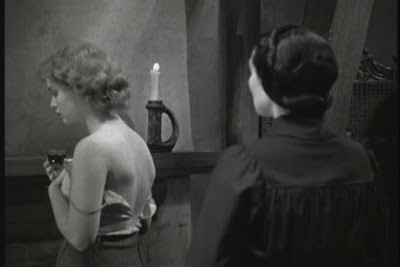A major influence on Anne Rice's vampire novels as well as a canonical work of queer horror (the excellent Shudder documentary miniseries Queer for Fear covers it at length), Dracula's Daughter is in the top tier of '30s Universal horror movies despite having a generally subdued tone and almost no special effects (we never see our vampires turn into vampires) and confining most of the horror off-screen. The film does so much with suggestion, atmosphere, performance, movement, and dialogue (and smoke machines) that I didn't really miss any of the bells and whistles (though I wish we could have seen Drac's daughter show some vampire fangs). If you're receptive to it, the film will give your imagination plenty of room to run wild.
Set in London and filmed on Universal's Hollywood sets, Dracula's Daughter opens with two policemen stumbling across a dead body. An elderly man (Edward Van Sloan) appears out of the shadows, telling the police that his name is Von Helsing (weirdly changed from Van Helsing even though he's the only actor reprising his role from Dracula) and that the body is a bug-eating man named Renfield. He also tells them there is another dead body nearby and that he killed that body. It was no man, though; it was a vampire. The dead bloodsucker, with a stake through his heart, is, of course, Count Dracula.
The inexperienced local policemen think the old man's a murdering kook and call in Scotland Yard. While guarding the bodies and awaiting Scotland Yard's arrival, the most easily scared of the two policemen encounters a late-night visitor, Countess Marya Zaleska (Gloria Holden). After she's denied visitation, she hypnotizes the hapless cop with help from a mysterious jeweled ring, steals Dracula's body, and burns the remains on a pyre in a fog-shrouded country cemetery.
Marya is, of course, Dracula's daughter. She has the same curse of vampirism, but, unlike her pops, she hasn't fully embraced it. She's tortured by it but can't resist giving in to its urges. She's enabled in her vampiric lifestyle by her oddball assistant Sandor (Irving Pichel). (Pichel had parallel careers as an actor and director. Horror fans will probably know him best from his debut directorial film The Most Dangerous Game, co-directed with Ernest B. Schoedsack, who co-directed King Kong with Merian C. Cooper. Heeeyyyy, that's a lotta co-directin' ovah heah!) We're not quite sure what Sandor's deal is at this point in the film, but the relationship will become clearer by the film's end.
Interestingly, Sandor is instructed to procure young women as victims for Marya through a ruse that they will pose as subjects for Marya's paintings, but when Marya is seen on the hunt for herself, she chooses male victims. There's a real internal struggle here not just between whether to be a vampire or not, but also between who will get the fangs.
Back in Van Helsing land, the old doc is trying to convince Scotland Yard that vampires exist and he's not a cold-blooded killer, so he asks former student turned prominent psychiatrist Jeffrey Garth (Otto Kruger) to help him out. Garth doesn't believe the vampire story, but he's a big fan of Van Von Helsing, so he's willing to help.
Meanwhile, Countess Marya believes Garth is just the man to stop her vampiric urges and turn her into a "normal" woman, so she enlists him as her psychiatrist, much to the chagrin of both Sandor and Garth's secretary/personal assistant Janet Blake (Marguerite Churchill), who is not-so-secretly in love with Garth and also not afraid to give him the business. Kruger is a much more interesting actor and his character has more personality than a lot of the milquetoast dud romantic male leads in '30s horror, but he's not particularly erotically charismatic or handsome, so it's still a mystery why both Janet and Marya are so drawn to him other than for narrative requirements. The real sparks in the movie are between the women characters.
The gay subtext is pretty obvious, though much of it may have still sailed over my head if I hadn't watched Queer for Fear. It leaps from subtext to text, however, in the tense, beautifully filmed scenes between Marya and a young victim named Lili (Nan Grey). The sexual tension in these scenes is almost a visible character in the room, and the facial expressions and movements of the actors captured by the camera are unmistakably filled with desire, lust, and the nervousness and fear that exist alongside desire.
Lambert Hillyer, who was surprisingly primarily a director of westerns (of his hundreds of films and television episodes, only two are horror), has a natural touch for the material, and he does so much with closeups, shadow, and suggestion. I wish he'd directed more horror, but he loved his westerns. He's also the first director to put Batman on the big screen, directing a Batman serial in 1943. If Hillyer was an odd but ultimately successful choice for director, the screenwriters, Garrett Fort and John L. Balderston, were horror veterans, co-writing the screenplays for Universal's Dracula and Frankenstein. Fort also worked on The Devil-Doll, while Balderston's other horror credits include The Mummy, Mystery of Edwin Drood, Bride of Frankenstein, Mark of the Vampire, Mad Love, and The Mummy's Hand.
If you want some classic vampire bat flying, fang-baring, neck-biting, blood-trickling, garlic-recoiling action, you will be disappointed in Dracula's Daughter (though there is a scene set in Transylvania where we get to hang out in Dracula's castle), but if you're open to an atmospheric, slow-burn, character-based, woman-centric approach to vampirism, it's a damn good movie. And it's pretty effectively creepy. I liked it a lot.













No comments:
Post a Comment